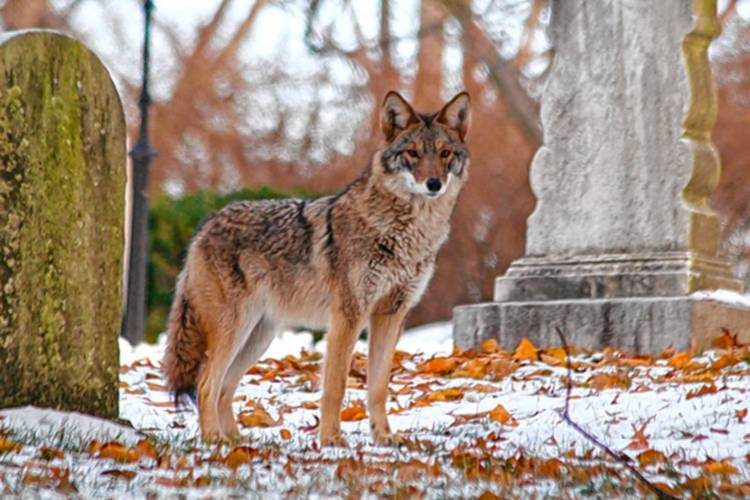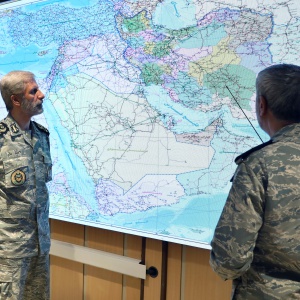Opinion: Protecting NH’s coyotes

In this 2008 photo, a coyote stands in Mount Auburn Cemetery in Cambridge, Mass. Josh Harrison via AP
| Published: 02-05-2024 4:17 PM |
Christine Schadler, Webster, New Hampshire Wildlife Coalition.
Mike Dunbar’s piece (Monitor, 1/30) provided fairly accurate information on the contentious issue of coyote hunting. Since the coyote’s arrival in New Hampshire in the 1940s, policy guiding their conservation has been informed by myth rather than science. The NHFG Commission, comprised of hunters and trappers, sets the rules and reflects the bias of only a small group of hunters who believe, despite evidence to the contrary, that if killing coyotes should stop, their numbers would soar out of control. The mantra is that killing equals control.
The truth lies in the numbers. For the past two centuries, federal and state governments have attempted to eradicate, in some western areas, and control, in others, coyotes. Today, in response to constant killing, trapping, poisoning, and killing contests, there are millions more coyotes in the U.S., which have expanded their range into Canada, down through Central America and have now reached South America.
It is not intuitive that the more they are killed, the more abundant they become. This is the coyote’s Achilles heel, however. Their natural ability to compensate for population losses means they are regarded as an infinitely renewable ‘resource.’ Thus, an open season on coyotes persists, even while most hunters deplore this policy and see it as a black eye on hunting in general. And well they should.
HB 1100 is a bill that asks for a five-month reprieve from hunting so coyotes can raise their young. Other furbearers in New Hampshire are protected while they whelp their young, except for the coyote. If adult members of a pack are killed during denning, the pups likely starve. In my community last spring, landowners witnessed firsthand pups stranded after parents had been killed. They wandered through backyards seeking shelter beneath porches. Two, close to death, cried until they died from starvation.
Coyotes rely for over 60% of their prey on small mammals such as rodents. Pups need to be taught by parents how and what to hunt. If they are given time to learn, they tend not to become a nuisance, but rather a benefit by controlling rats and mice, some of which carry Lyme. If early lessons are not learned, pups that survive are more likely to go after alternate prey, which can become a problem for us. Studies confirm that breaking apart a pack destabilizes their social structure, leading to chaotic behavior.
Finally, ethical consideration comes into play here. The commissioners at NHFG use words like “vicious predator” and “lacking a moral compass” to describe this creature which, like all wildlife, operates out of need, not preference or intent. Starvation is always imminent. Making policy decisions based on personal bias or emotion is inappropriate when considering the management of a wild animal that provides many ecological services and whose howl nourishes the spirit of the wild in many.
Article continues after...
Yesterday's Most Read Articles
 New Hampshire legalizes public alcohol consumption in designated ‘social districts’
New Hampshire legalizes public alcohol consumption in designated ‘social districts’
 State rules Epsom must pay open-enrollment tuition to other school districts, despite its refraining from the program
State rules Epsom must pay open-enrollment tuition to other school districts, despite its refraining from the program
 Town turmoil: Chichester town administrator resigns again
Town turmoil: Chichester town administrator resigns again
 New Hampshire providers brace for Medicaid changes that reach beyond healthcare
New Hampshire providers brace for Medicaid changes that reach beyond healthcare
 Warner town administrator granted restraining order against selectman
Warner town administrator granted restraining order against selectman
 NH judge decides to pause Trump’s birthright citizenship order
NH judge decides to pause Trump’s birthright citizenship order







 Opinion: Trumpism in a dying democracy
Opinion: Trumpism in a dying democracy Opinion: What Coolidge’s century-old decision can teach us today
Opinion: What Coolidge’s century-old decision can teach us today Opinion: The art of diplomacy
Opinion: The art of diplomacy Opinion: After Roe: Three years of resistance, care and community
Opinion: After Roe: Three years of resistance, care and community
